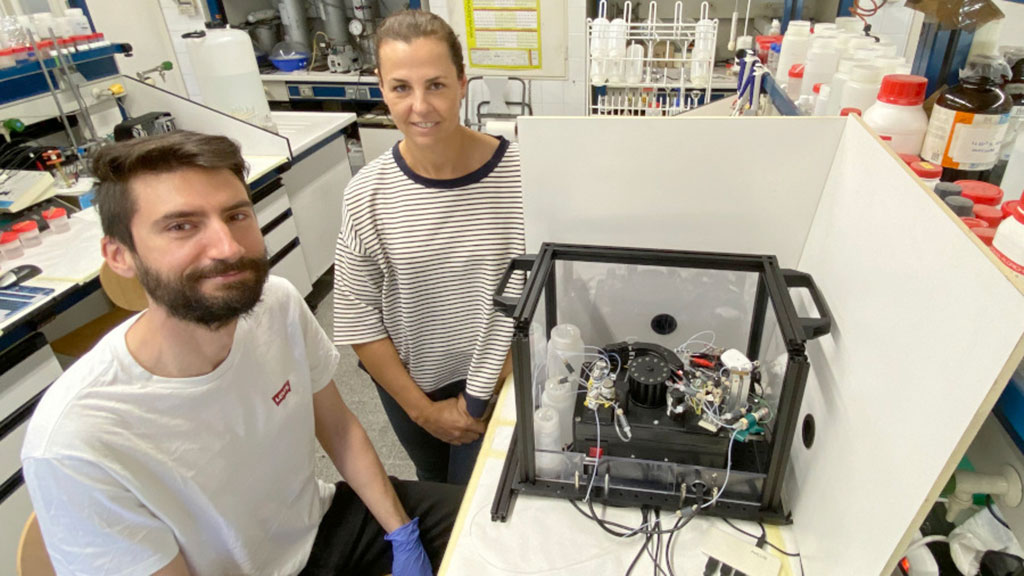New Analyzer Monitors Blood Ammonium Levels at POC to Facilitate Quick Medical Decisions
|
By LabMedica International staff writers Posted on 04 Nov 2022 |

Ammonium is a biomarker used to diagnose a series of rare hereditary metabolic disorders, such as the primary disorders of the urea cycle and different organic acidemias, as well as other metabolic and environmental conditions affecting the liver’s function, which can cause a secondary dysfunction of the urea cycle. Ammonium is also useful in the study and monitoring of different hepatopathies (diseases affecting the normal functioning of the liver) caused by the consumption of alcohol or other drugs, medicines and other environmental factors. In all of these disorders, an excess of ammonium is produced, putting the patient’s health at risk. Values surpassing 200 micromoles per liter of blood are considered severe cases of hyperammonemia (high concentration of ammonium in blood) which can cause irreversible damage to the brain, and can even lead to death, if values surpass 500 micromoles per liter. Therefore, an early diagnosis in real time is crucial to minimizing the impact of a hyperammonemia episode on neurological functions. Currently, patients diagnosed with disorders which include hyperammonemia episodes must periodically be visited at hospital, where a blood sample is taken, which then must be treated an analyzed in the lab.
Now, researchers at the Autonomous University of Barcelona (UAB, Barcelona, Spain) have developed an analyzer that monitors the level of ammonium in the patient’s blood using a decentralized method at the point-of-care, instead of sending blood samples to be analyzed in hospital laboratories, where traditional equipment is used. The new device aims to decentralize the blood ammonium determination, making the analysis possible at smaller healthcare centers with direct blood measurements and no need for previous treatments. This would represent multiplying the number of monitoring sites, simplifying the process and reducing the time needed to take medical decisions.
The device uses a microfluidic platform which includes a potentiometric detection system and a gas separation membrane. In this manner, it is possible to automatically separate the ammonium in the form of ammonia from the rest of the complex matrix of blood, obtaining a selective detection free of any other type of interferences. This guarantees a precise and exact determination of ammonium concentration in whole blood and not in plasma, which is the method conventionally used to analyze this parameter. The research team is preparing a prototype that will function under semi-autonomous conditions. Once the device is ready, it will measure all ammonium samples analyzed with the conventional method and with the new equipment created by researchers.
“Increasing the frequency of blood analyses to determine ammonium levels is of vital importance,” explained UAB researcher Mar Puyol, director of the study. She goes on to say that: “Reducing the excess of ammonium in a patient with hyperammonemia is done by restricting protein intake, using drugs to enhance ammonium elimination, and dialysis and hemofiltration in the most acute cases, so that the evolution of the patient will be more favorable the faster the doctors act, and that can be achieved by using the point-of-care analyzers such as the one we have developed.”
Puyol warns that “hundreds of samples will be necessary before the final prototype of the point-of-care analyzer is validated. The next stage will then be industrializing the device to launch it into the market. There are still several stages before reaching that scenario, but the device is expected to become an economic alternative that can facilitate the monitoring of liver diseases in developing countries as well.”
Related Links:
UAB
Latest Clinical Chem. News
- Noninvasive Blood-Glucose Monitoring Method to Replace Finger Pricks for Diabetics
- POC Breath Diagnostic System to Detect Pneumonia-Causing Pathogens
- Online Tool Detects Drug Exposure Directly from Patient Samples
- Chemical Imaging Probe Could Track and Treat Prostate Cancer
- Mismatch Between Two Common Kidney Function Tests Indicates Serious Health Problems
- VOCs Show Promise for Early Multi-Cancer Detection
- Portable Raman Spectroscopy Offers Cost-Effective Kidney Disease Diagnosis at POC
- Gold Nanoparticles to Improve Accuracy of Ovarian Cancer Diagnosis
- Simultaneous Cell Isolation Technology Improves Cancer Diagnostic Accuracy
- Simple Non-Invasive Hair-Based Test Could Speed ALS Diagnosis
- Paper Strip Saliva Test Detects Elevated Uric Acid Levels Without Blood Draws
- Prostate Cancer Markers Based on Chemical Make-Up of Calcifications to Speed Up Detection
- Breath Test Could Help Detect Blood Cancers
- ML-Powered Gas Sensors to Detect Pathogens and AMR at POC
- Saliva-Based Cancer Detection Technology Eliminates Need for Complex Sample Preparation
- Skin Swabs Could Detect Parkinson’s Years Before Symptoms Appear
Channels
Molecular Diagnostics
view channel
Rapid Diagnostic Breakthrough Simultaneously Detects Resistance and Virulence in Klebsiella Pneumoniae
Antibiotic resistance is a steadily escalating threat to global healthcare, making common infections harder to treat and increasing the risk of severe complications. One of the most concerning pathogens... Read more
DNA Detection Platform Enables Real-Time Molecular Detection
A next-gen DNA detection platform enables real-time molecular detection by detecting nucleic acids directly without enzymes or thermocyclers, thereby slashing costs, reducing complexity, and boosting reliability... Read moreHematology
view channel
MRD Tests Could Predict Survival in Leukemia Patients
Acute myeloid leukemia is an aggressive blood cancer that disrupts normal blood cell production and often relapses even after intensive treatment. Clinicians currently lack early, reliable markers to predict... Read more
Platelet Activity Blood Test in Middle Age Could Identify Early Alzheimer’s Risk
Early detection of Alzheimer’s disease remains one of the biggest unmet needs in neurology, particularly because the biological changes underlying the disorder begin decades before memory symptoms appear.... Read more
Microvesicles Measurement Could Detect Vascular Injury in Sickle Cell Disease Patients
Assessing disease severity in sickle cell disease (SCD) remains challenging, especially when trying to predict hemolysis, vascular injury, and risk of complications such as vaso-occlusive crises.... Read more
ADLM’s New Coagulation Testing Guidance to Improve Care for Patients on Blood Thinners
Direct oral anticoagulants (DOACs) are one of the most common types of blood thinners. Patients take them to prevent a host of complications that could arise from blood clotting, including stroke, deep... Read moreImmunology
view channel
Blood Test Could Identify Colon Cancer Patients to Benefit from NSAIDs
Colon cancer remains a major cause of cancer-related illness, with many patients facing relapse even after surgery and chemotherapy. Up to 40% of people with stage III disease experience recurrence, highlighting... Read moreBlood Test Could Detect Adverse Immunotherapy Effects
Immune checkpoint inhibitors have transformed cancer treatment, but they can also trigger serious immune-related adverse events that damage healthy organs and may become life-threatening if not detected early.... Read moreMicrobiology
view channel
Breakthroughs in Microbial Analysis to Enhance Disease Prediction
Microorganisms shape human health, ecosystems, and the planet’s climate, yet identifying them and understanding how they are related remains a major scientific challenge. Even with modern DNA sequencing,... Read more
Blood-Based Diagnostic Method Could Identify Pediatric LRTIs
Lower-respiratory tract infections (LRTIs) are a leading cause of illness and death worldwide, and pneumonia is the leading infectious cause of death in children under five, claiming the lives of over... Read morePathology
view channel
AI Tool Simultaneously Identifies Genetic Mutations and Disease Type
Interpreting genetic test results remains a major challenge in modern medicine, particularly for rare and complex diseases. While existing tools can indicate whether a genetic mutation is harmful, they... Read more
Rapid Low-Cost Tests Can Prevent Child Deaths from Contaminated Medicinal Syrups
Medicinal syrups contaminated with toxic chemicals have caused the deaths of hundreds of children worldwide, exposing a critical gap in how these products are tested before reaching patients.... Read more
Tumor Signals in Saliva and Blood Enable Non-Invasive Monitoring of Head and Neck Cancer
Head and neck cancers are among the most aggressive malignancies worldwide, with nearly 900,000 new cases diagnosed each year. Monitoring these cancers for recurrence or relapse typically relies on tissue... Read moreTechnology
view channel
Machine Learning Models Diagnose ALS Earlier Through Blood Biomarkers
Amyotrophic lateral sclerosis (ALS) is a rapidly progressive neurodegenerative disease that is notoriously difficult to diagnose in its early stages. Early symptoms often overlap with other neurological... Read more
Artificial Intelligence Model Could Accelerate Rare Disease Diagnosis
Identifying which genetic variants actually cause disease remains one of the biggest challenges in genomic medicine. Each person carries tens of thousands of DNA changes, yet only a few meaningfully alter... Read moreIndustry
view channel
BD and Penn Institute Collaborate to Advance Immunotherapy through Flow Cytometry
BD (Becton, Dickinson and Company, Franklin Lakes, NJ, USA) has entered into a strategic collaboration with the Institute for Immunology and Immune Health (I3H, Philadelphia, PA, USA) at the University... Read more





















